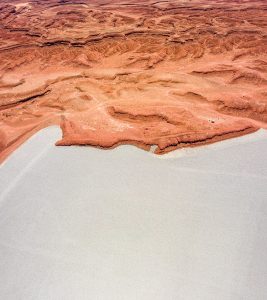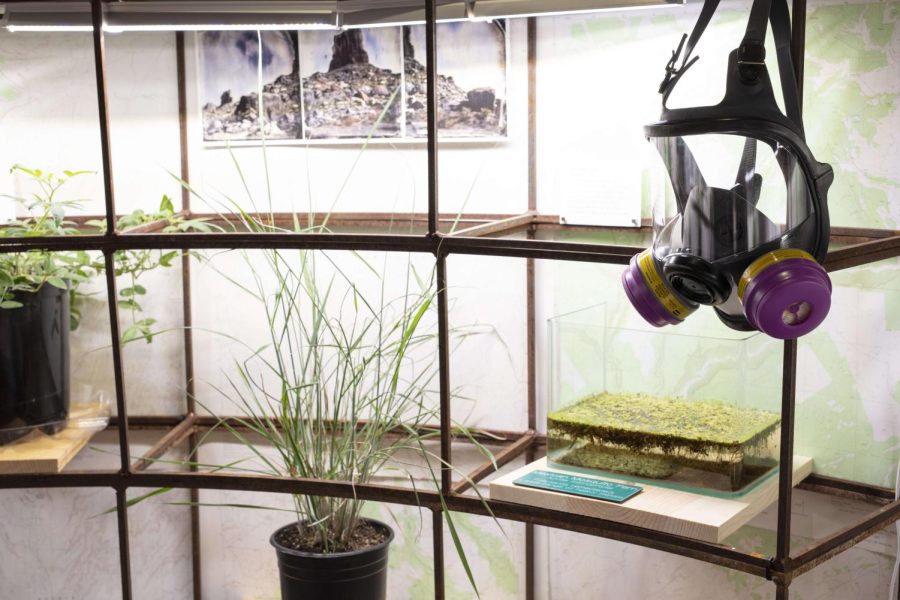‘Air’ at the UMFA with Curator Whitney Tassie and Artist Will Wilson
September 15, 2022
In 1968, artist Willoughby Sharp unveiled “Air Art” — an exhibit exploring the possibilities of air and the dematerialization of the physical art piece. 54 years later, a new exhibit at the UMFA, simply titled “Air,” pushes Sharp’s concepts into novel territory. Curated by Whitney Tassie and showcasing 16 artists, the exhibit’s justice-driven grounding aims to inspire tangible action in visitors.
“By emphasizing that art didn’t have to be seen, [Sharp] underscored that the idea behind a work of art was essential, perhaps trumping its physical presence,” Tassie said of “Air Art.” “Today, conceptual art is more widely accepted and artists are engaging with the invisible resource to make work about issues that are central to them.”
A New Kind of Laboratory
Will Wilson is among the artists with work in “Air.” Wilson’s “AIR Lab” greenhouse is a reimagination of the Diné hogan, a sacred Indigenous dwelling. “AIR Lab” at the UMFA is the latest installation of Wilson’s ongoing “Auto Immune Response (AIR)” series, which follows an imaginary protagonist as he moves through an ever-changing world.
Red Butte Gardens’ horticulture team and Tucson Arizona’s Native Seeds Search collaborated with Wilson to source and maintain the featured plants. “Installing “AIR Lab” took quite a bit of planning. Growing plants in a controlled museum environment is very tricky.
“We are so grateful to our partners at Red Butte Gardens for their knowledge and skills that helped us select and grow the right plants for Wilson’s vision,” Tassie said.
The Four Corners potato and other various species that naturally decontaminate soil are on rotation with the help of Red Butte’s team. The Four Corners potato (Solanum jamesii) is native to the Southwest and was formerly an essential food source for its Indigenous people.
“The greenhouse is a site for research and investigation,” Wilson said. “It could be about phytoremediation, it could be about this cool new historical food source that’s been rediscovered … artists often are really good at dreaming up possible solutions to complex problems in their imaginings, so I guess it’s trying to bridge the place between imagining and bringing that research into reality.”
For Wilson, “AIR Lab” is a safe haven for Indigenous knowledge and hope for the future.

Exposing Toxicity
While “AIR Lab” is a part of Wilson’s more conceptual work, his photographic survey of uranium disposal in the Southwest is also featured alongside the greenhouse.
“[Auto Immune Response] is much more fictional, but I think of the “Connecting the Dots” project, the abandoned uranium mines, as much more documentary, but they’re not unrelated — they’re both stories of environmental catastrophe on one end, and bad stewardship on another,” Wilson said.
This focused inquiry into environmental change and its effect on the Diné people was more than a perfect fit for Tassie’s vision. “While the work focuses on issues related to environmental racism, specifically how abandoned uranium mines are contaminating the Navajo Nation, it’s also hopeful,” Tassie said. “Wilson has used the “AIR Lab” to explore ways of thinking and acting that can address that injustice.”
Through his various ongoing projects, Wilson has offered a new perspective on the American Southwest. “You know the West as this expansive frontier that’s ripe for exploitation or extraction, versus a place where people have lived and had a relationship with the land for thousands and thousands of years,” he said.
Wilson will be presenting a free art talk on “AIR Lab” Friday, Oct. 7 at the UMFA from 6:30-8 p.m. “Air” opened to the public on July 16 and will run through Dec. 11.








